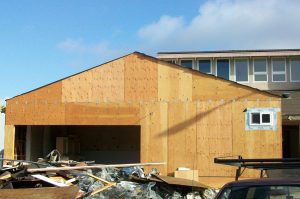
Seismic Drift for 2-story Single Family Dwellings
Q. I am designing a new two story single-family dwelling with plenty of space between this house and the next house. Do I need to do a drift analysis per ASCE 7-10 Section 12.8.6? The plan reviewer is asking for it but I can’t understand why. In my opinion, drift is relevant when a building is close to another. That is not the case with a single-family home on a large lot. Maybe ASCE Section 12.8.6 should provide some exceptions.
A. We are not aware of any provision in ASCE 7-10 or the 2012 IBC that exempts you from calculating drift other than Section 12.14, Simplified Alternative Structural Design Criteria for Simple Bearing Wall or Building Frame Systems, which reads:
12.14.8.5 Drift Limits and Building Separation
Structural drift need not be calculated. Where a drift value is needed for use in material standards, to determine structural separations between buildings or from property lines, for design of cladding, or for other design requirements, it shall be taken as 1 percent of structural height, hn, unless computed to be less. All portions of the structure shall be designed to act as an integral unit in resisting seismic forces unless separated structurally by a distance sufficient to avoid damaging contact under the total deflection.
The drift limit in ASCE 7-10 Section 12.12.1 is imposed primarily to minimize damage to nonstructural components attached to a structure. Structural separation is addressed specifically by ASCE 7-10 Section 12.12.3.
Q. Thank you for this answer. Maybe I should change my seismic analysis to the Simplified Method.
A. Yes, if your building is eligible to be designed by the Simplified Method of ASCE 7.10 Section 12.14, the applicable drift limit will be deemed to have been satisfied automatically. However, please note the important limitations in Section 12.14.1.1.
Q. I appreciate your pointing out the limitations. I think that the building code in general is too complicated for single-family residences. The books are getting thicker every time a new one comes out. We now have five chapters for wind design. Even the simplified methods are not so simple. Seismic analysis is not so bad yet. But all have a lot of checking this and that with different formulas, factors, load combinations and methods. It is very time consuming and it doesn’t seem to make any difference on the basic final results.
I started working under the 1979 UBC. I really haven’t seen much of a difference, either higher or lower, in overall loads and design results with all these changes in methods of calculating wind and seismic forces in the past 30+ years. Just much more complicated methods of calculating the loads. It is just a bit frustrating.
A. You reflect the sentiments of many out there. We hear very similar complaints all the time. However, this is little different from many other things that are happening to us. Life in general is much more complicated than it was in 1979. This trend may not be irreversible. But at this point in time, it sure looks that way. All we can do is try to cope.